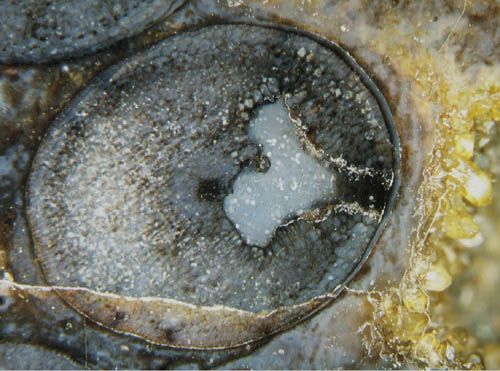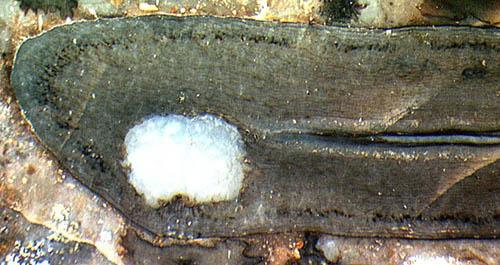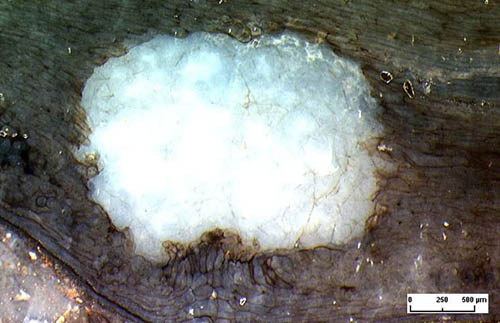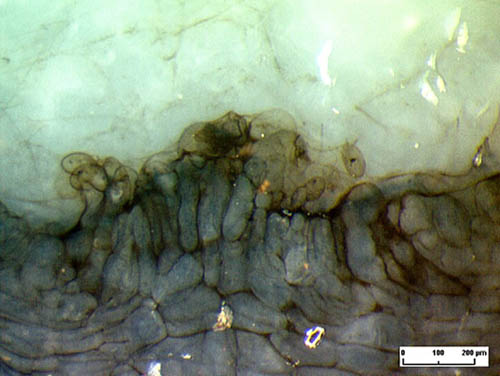Hole repair in Rhynie chert plants
Holes
eaten into live Lower Devonian plants are seldom described phenomena.
Arthropod borings in Rhynia
gwynne-vaughani are mentioned in a
comprehensive survey of herbivory by Labandeira
[1], where the Rhynie
chert is chosen as "early flagship biota" for the "1. herbivore
expansion phase". The borings in Rhynie chert plants are thought to be
caused by mites and hexapods.
 Holes
gnawed into Aglaophyton
sporangia to get access to the spores have been described, apparently
for the first time, in Rhynie
Chert News 7
.
Holes
gnawed into Aglaophyton
sporangia to get access to the spores have been described, apparently
for the first time, in Rhynie
Chert News 7
.
Cavities in
Aglaophyton
shoots are a common sight but
often they cannot easily be assigned to a certain cause. Two
rather well preserved specimens of
Aglaophyton
(former Rhynia major)
with damage due to herbivores have
been found recently (Figs.1,2). By lucky incidence, the cut reveals the
access hole to the cavity in Fig.1.
Fig.1:
Aglaophyton,
slightly tilted cross-section with cavity in the tissue
and access hole, width about 0.4mm, obviously made by some
herbivore.
Width
of the picture 5.5mm.
The creature apparently did not prefer
a certain type of tissue: It did not specially go for the region around
the xylem strand thought to represent the nutrient-rich phloem, nor for
the mushroom taste of the layer with dark clots in Fig.2, where the
fungus Glomites
rhyniensis has set up a relationship with the plant
known as arbuscular mycorrhiza [2].
The absence of coprolites seems to indicate that the borings did not
serve as burrows for dwelling but as grazing grounds only. Obviously
the damage occurred to the live plant, judging from the response of
cells along the boundary and the apparent formation of new
cells. A cavity of similar but less distinct shape is seen in [3].



Fig.2: Aglaophyton
axis bending out of the cut plane on the left,
with cavity, 2.5mm wide, probably made by herbivorous
arthropod.
Fig.3, detail of Fig.2: Response of the
plant with the aim to replace some of the lost tissue below.
Fig.4, detail of Fig.3, suggesting the formation
of new cells.
The
fungus hyphae faintly seen above must have grown later when the plant
was
submerged by flooding and the cavity was filled with water.
Photographs by H.
Sahm
(Figs.2-4).
Some of the cavities in Aglaophyton cannot
easily be assigned to either fungus activity as in
Rhynie
Chert News 4
and 21
or to gnawing creatures as in Rhynie
Chert News 7
and the samples shown here.
Similar
phenomena as seen in the above pictures had been described as "...
active cell division that can without doubt be interpreted as a wound
reaction." [4]
H.-J. Weiss
2010
[1] C.C.
Labandeira : The four phases of
plant-arthropod
associations in deep time.
Geologica Acta 4(2006), 409-38.
[2] T.N.Taylor
et al.: Fossil arbuscular mycorrhizae from
the Early Devonian.
Mycologia 87(1995), 560-73.
[3] P.G. Kevan, W.G. Chaloner,
D.B.O. Savile: Interrelationships
of early terrestrial arthropods and plants.
Palaeontology 18
Part 2 (1975), 391-417, Plate 54.
[4] R. Kidston,
W.H. Lang, On Old Red Sandstone plants
showing structure, ... Part IV
Trans. Roy. Soc.
Edinburgh 51(1921), 831-54
 |
 |
37 |


 Holes
gnawed into Aglaophyton
sporangia to get access to the spores have been described, apparently
for the first time, in Rhynie
Chert News 7
.
Holes
gnawed into Aglaophyton
sporangia to get access to the spores have been described, apparently
for the first time, in Rhynie
Chert News 7
.



